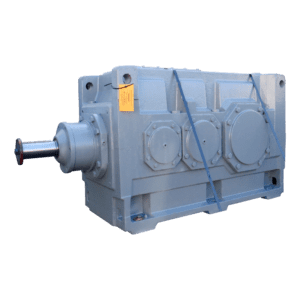
Industrial gearboxes come in a variety of types to suit various applications and are a necessary component in many machines and systems.
The top 10 industrial gearbox types, their benefits and drawbacks, and the most typical uses will all be covered in this article.
1. Helical Gearboxes
In the industrial sector, helical gearboxes are the most prevalent. Widely used in applications that demand high speeds and high loads, they transmit torque using helical gears. Operating smoothly and quietly is made possible by the helical gears’ angled cut. The high efficiency of helical gearboxes and their ability to transmit up to 98% of the input power makes them the perfect option for numerous industrial applications.
Advantages:
High efficiency
Smooth and quiet operation
Can handle high speeds and loads
Disadvantages:
More complex design than other gearboxes
Can be more expensive than other types of gearboxes
Applications:
Industrial automation
Power generation
Mining and quarrying
Paper and pulp industry
2. Planetary Gearboxes
Epicyclic gearboxes, or planetary gearboxes, are another name for them. They consist of the ring gear, planetary gear, and central sun gear. The planetary gears are mounted on a carrier and revolve around the central sun gear. Compact and able to handle large torques, planetary gearboxes are appropriate for a variety of applications.
Advantages:
High torque handling capacity
Compact design
High efficiency
Disadvantages:
More complex design than other gearboxes
More expensive than some other types of gearboxes
Applications:
Robotics
Printing presses
Conveyor systems
Packaging machines
3. Bevel Gearboxes
Power is transferred between shafts that are at an angle to one another using bevel gearboxes. To transfer torque, they make use of bevel gears, which are conical in shape. Industrial machinery and heavy machinery frequently employ bevel gearboxes.
Advantages:
Can transmit power between shafts at an angle
Compact design
High efficiency
Disadvantages:
Limited torque handling capacity
Limited speed range
Applications:
Mining and quarrying
Marine industry
Heavy machinery
Steel and metal processing
4. Worm Gearboxes
A worm gear and a worm wheel make up worm gearboxes. Power is transferred using them between shafts that are perpendicular to one another. Worm gearboxes are frequently employed in applications where high reduction ratios are necessary.
Advantages:
High reduction ratio
Smooth operation
Self-locking design
Disadvantages:
Lower efficiency compared to some other types of gearboxes
Limited torque handling capacity
Applications:
Material handling
Conveyor systems
Elevators and lifts
Food processing
5. Spur Gearboxes
The most basic kind of industrial gearbox is a spur gearbox. They transmit power between parallel shafts using straight-cut gears. Applications requiring low speed and low torque frequently employ spur gearboxes.
Advantages:
Simple design
Low cost
Low noise
Disadvantages:
Limited torque handling capacity
Limited speed range
Applications:
Automotive industry
Packaging machines
Textile industry
Material Handling
6. Hypoid Gearboxes
Similar to bevel gearboxes, hypoid gearboxes are more intricately designed. For the purpose of transferring torque between shafts that are at an angle to one another, they use hypoid gears, which have a curved shape. Applications that call for high torque and low speed frequently use hypoid gearboxes.
Advantages:
High torque handling capacity
Can transmit power between shafts at an angle
Compact design
Disadvantages:
More complex design than other gearboxes
More expensive than some other types of gearboxes
Applications:
Automotive industry
Heavy machinery
Robotics
Industrial automation
7. Cycloidal Gearboxes
In cycloidal gearboxes, cycloidal disks are used to transfer torque between shafts. The disks’ distinct shape makes for a smooth, effective operation. Applications that demand high precision and little backlash frequently use cycloidal gearboxes.
Advantages:
High precision
Low backlash
Can handle high shock loads
Disadvantages:
More complex design than other gearboxes
Lower efficiency compared to some other types of gearboxes
Applications:
Robotics
Printing presses
Machine tools
Packaging machines
8. Harmonic Drive Gearboxes
Torque is transferred by the deformation of an inner ring on an elastic outer ring in harmonic drive gearboxes. They are frequently utilized in applications that call for high precision and minimal backlash.
Advantages:
High precision
Low backlash
Can handle high torque
Disadvantages:
More complex design than other gearboxes
More expensive than some other types of gearboxes
Applications:
Robotics
Aerospace industry
Semiconductor industry
Medical equipment
9. Parallel Shaft Gearboxes
In parallel shaft gearboxes, torque is transferred between shafts using gears that are parallel to one another. They are frequently employed in situations where high speeds and low to medium torque are necessary.
Advantages:
High speed capability
Compact design
High efficiency
Disadvantages:
Limited torque handling capacity
Limited application range
Applications:
Printing presses
Machine tools
Textile industry
Material handling
10. Right-Angle Gearboxes
Transmission of power between shafts that are at a right angle to one another is accomplished by right-angle gearboxes. To transmit torque, they use worm or bevel gears. Applications that call for high torque and low speed frequently use right-angle gearboxes.
Advantages:
Can transmit power between shafts at a right angle
Compact design
High torque handling capacity
Disadvantages:
Lower efficiency compared to some other types of gearboxes
Limited speed range
Applications:
Mining and quarrying
Marine industry
Heavy machinery
Steel and metal processing
Industrial gearboxes are a crucial component of numerous machines and systems, and they are available in a variety of types to suit various applications. Torque, speed, efficiency, and cost are just a few of the application-specific criteria that will determine which gearbox to use. Engineers and designers can select the best industrial gearbox for their application and guarantee the optimum performance of their machines and systems by being aware of the various types of industrial gearboxes and their advantages as well as their disadvantages.
Read more:
Top 10 industrial gearbox types for high performance machines and systems






